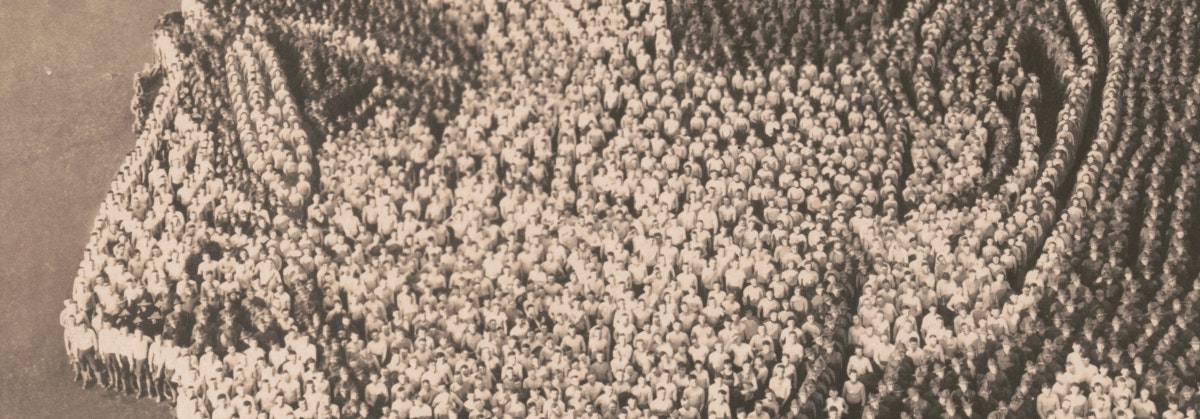
The “Living Photographs” of Mole and Thomas
In search of some eye-catching imagery to boost morale surrounding US involvement in WWI, the US military commissioned the English-born photographer Arthur Mole and his assistant John Thomas to make a series of extraordinary group portraits. Between 1915 and 1921, with the dutiful help of thousands of servicemen and staff from various US military camps, the duo produced around thirty of the highly patriotic images, which Mole labelled "living photographs".
As one might imagine, the creation of each photograph was somewhat of a military exercise in itself, taking a week or more to prepare. Firstly, the desired image would be traced with wire onto a glass plate mounted to Mole's camera, which he would then take to the top of an 80 foot high viewing tower. Looking through the template, armed with a megaphone and large pointing stick, Mole would then oversee the laborious nailing down of miles and miles of lace edging, tracing out the pattern. The next stage was fairly straight forward, the servicemen would then simply need to fill the design.
Making use of anamorphic perspective, the images would not make much sense from overhead or on the ground, but only become intelligible at one particular vantage point — where Mole would be positioned atop his tower with his 11 x 14-inch view camera. This would make for some wonderful skewing of numbers, and itself, acts as a great example of perspective at work. The Statue of Liberty image, for example, required a total of 18,000 men: just 17 at the base but, more than half a mile away, 12,000 in the torch. Sadly it seems no one thought to fly a photographer overhead and capture what would have been a wonderfully skewed vision of Liberty, with enormous bulging torch and minuscule feet.
While the logic in Mole calling them "living photographs" is self-evident, in another important sense it's also somewhat of a misnomer, as Louis Kaplan notes in an article for Cabinet:
From the photographer’s perspective, the emblems are brought to life by means of the living soldiers who embody them. But one can also look at these images from the opposite perspective: we deaden the human beings into form and formation by making them into emblems. The emblem only comes into focus when the living element drops out of the group portrait in these spectacular optical illusions. This total subjection of the individual to the symbolic order also exposes the fascistic tendency inherent in such images. Mole’s “living photographs” thinly disguise the forces of death that in fact adhere to all community.
Human Statue of Liberty; 18,000 officers and men at Camp Dodge, Des Moines, Ia., ca. 1917/18.
Soldiers of the 164th Depot Brigade, Camp Funston, Fort Riley, Kansas, formed into the shape of the U.S. Armed Forces service flag, ca. 1918.
Sincerely yours, Woodrow Wilson, 21,000 officers and men, Camp Sherman, Chillicothe, Ohio., 1918.
The Human U.S. Shield; 30,000 officers and men, Camp Custer, Battle Creek, Mich., ca. 1918.
The Human Liberty Bell; 25000 officers and men at Camp Dix, New Jersey, ca. 1918.
Formation photograph of the American flag; sailors, near Great Lakes, ca. 1917.
The Human American eagle; 12,500 officers, nurses and men; Camp Gordon, Atlanta, Ga., ca. 1918.
Machine Gun Insignia; Machine Gun Training Center; 22500 officers and men, 600 machine guns; Camp Hancock, Augusta, Ga., ca. 1918.
Jan 5, 2017









